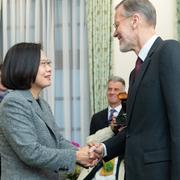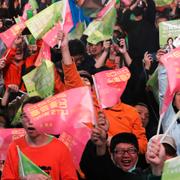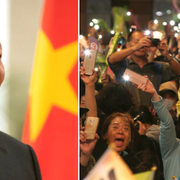
Taiwans val ett vägskäl för ekonomiska band till Kina
När Taiwan i dag går till val står frågan om tätare ekonomiska relationer till Kina i centrum, rapporterar flera medier.
Sittande president Tsai Ing-wen vill göra Taiwan mer ekonomiskt självständigt från Kina medan Nationalistpartiets Han Kuo-yu i stället vill se närmanden och menar att Taiwan bör integreras ekonomiskt med grannlandet.
Kina har historiskt gjort anspråk på Taiwan som i praktiken är en suverän stat.
bakgrund
Kina och Taiwans relation
Wikipedia (en)
"Taiwan, China", "Taiwan, Province of China", or "Taiwan Province, China" are a set of politically controversial and potentially ambiguous terms that characterize Taiwan and its associated territories as a province or territory of "China". The term "Taiwan, China" is used by Chinese media whenever Taiwan is referenced, even though the People's Republic of China (PRC) ― which is widely recognized by the international community as the legitimate representative of "China" ― does not exercise jurisdiction over areas controlled by the Republic of China (ROC). In English, "China" is inserted after "Taiwan" by adding ", China", per English grammar rules. In the Chinese language, however, the Chinese characters 中國 ("China") would be inserted in front of "台灣" (Taiwan) per Chinese convention to indicate the larger and higher-level entity first. For example, the word "China" would be inserted into video captions on television, whenever a person mentions the word "Taiwan" but the characters 中國 ("China") would be inserted in front of "Taiwan" (台灣) despite the fact that the person never said the word "China", to propagandize to the audience that Taiwan is part of China. (Video subtitling is standard practice on Chinese television due to the existence of many mutually unintelligible "Chinese dialects".) The term "Taiwan, Province of China" also sometimes appears in the drop-down menu of websites and computer software that show a list of ISO 3166-1 country names (see UN and ISO section below).The terms are contentious and potentially ambiguous because they relate to the controversial issues of the political status of Taiwan and Cross-Strait relations between "Taiwan" and "China", in that whether they are two separate countries or "two areas of one country". Since 1949, two countries with the name "China" (Two Chinas) actually exist, namely the Republic of China (ROC, founded 1912 and now commonly known as "Taiwan") and the People's Republic of China (PRC, founded 1949 and now commonly known as "China", and "the China"). However, only one "China" actually rules Taiwan, namely Republic of China, and has an administrative division called "Taiwan Province" but refers to it as "Taiwan Province, Republic of China"; whereas, the other "China", namely the People's Republic of China, which is the one internationally recognized as "China" (not the ROC), claims but does not control Taiwan as part of its territory.
The use of this term is officially and politically sanctioned by the Communist Chinese government as a way to claim and propagandize that Taiwan is under its sovereignty, since the PRC claims to be the legitimate government of "all China", which, according to its own definition, includes Taiwan also, despite its lack of control. Some of the ROC government disputes the PRC position and it, along with many of the Taiwanese people, considers this term incorrect and offensive, in that its use is a lie which denies the ROC's sovereignty and existence, reducing Taiwan's status to a province of the PRC (see "Taiwan, PRC"), and objects to its use. The term is particularly offensive to supporters of Taiwan Independence and want to disassociate Taiwan with "China" and a Chinese identity, (i.e., de-Sinicize), and consider it an oxymoron, i.e. in the view that Taiwan and China are different countries, and that the legitimacy of the ROC's rule of Taiwan is disputed in the first place.
Omni är politiskt obundna och oberoende. Vi strävar efter att ge fler perspektiv på nyheterna. Har du frågor eller synpunkter kring vår rapportering? Kontakta redaktionen



